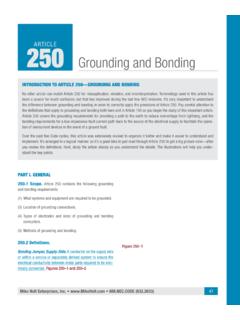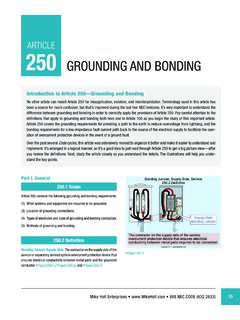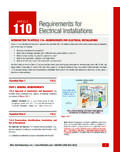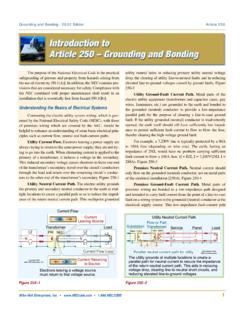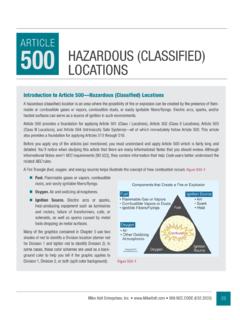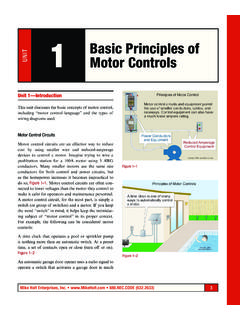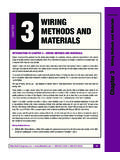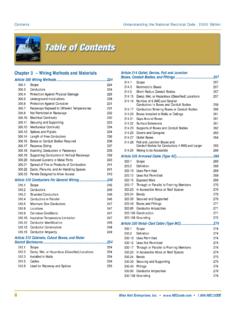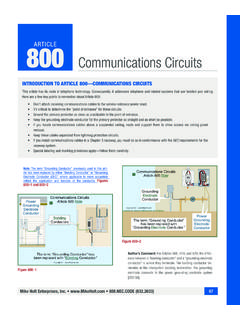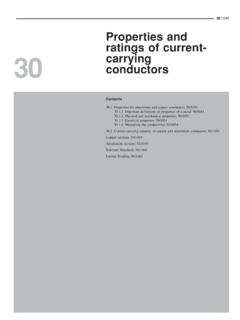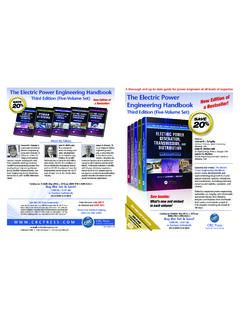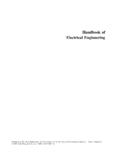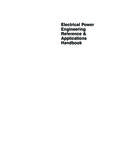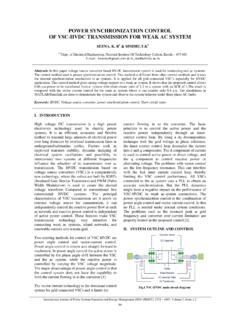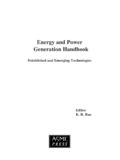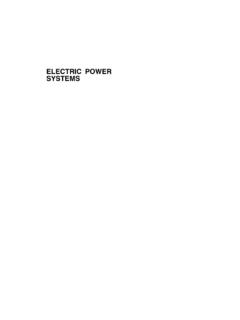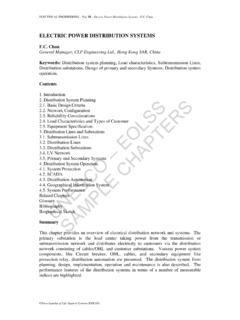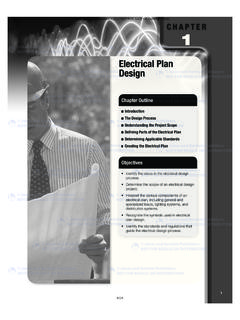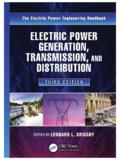Transcription of INTRODUCTION TO UNIT 1—ELECTRICIAN’S MATH AND …
1 UNIT1 Electrician s math and Basic electrical FormulasINTRODUCTION TO UNIT 1 ELECTRICIAN S math AND BASIC electrical FORMULASIn order to construct a building that will last into the future, a strong foundation is a prerequisite. The foundation is a part of the building that isn t visible in the finished structure, but is essential in erecting a building that will have the necessary strength to math and basic electrical concepts of this unit are very similar to the foundation of a building. The concepts in this unit are the essen-tial basics that you must understand, because you ll build upon them as you study electrical circuits and systems. As your studies continue, you ll find that a good foundation in electrical theory and math will help you understand why the NEC contains certain unit includes math and electrical fundamentals.
2 You ll be amazed at how often your electrical studies return to the basics of this unit. Ohm s law and the electrical formulas related to it are the foundation of all electrical student begins at a different level of understanding, and you may find this unit an easy review, or you may find it requires a high level of concentration. In any case, be certain that you fully understand the concepts of this unit and are able to successfully complete the ques-tions at the end of the unit before going on. A solid foundation will help in your successful study of the rest of this A ELECTRICIAN S MATHI ntroductionNumbers can take different forms: Whole numbers: 1, 20, 300, 4,000, 5,000 Decimals: , , , Fractions: 1/2, 1/4, 5 8, 4 3 Percentages: 80%, 125%, 250%, 500%You ll need to be able to convert these numbers from one form to another and back again, because all of these number forms are part of electrical work and electrical ll also need to be able to do some basic algebra.
3 Many people have a fear of algebra, but as you work through the material here you ll see there s nothing to Whole NumbersWhole numbers are exactly what the term implies. These numbers don t contain any fractions, decimals, or percentages. Another name for whole numbers is integers. DecimalsThe decimal method is used to display numbers other than whole numbers, fractions, or percentages such as, , , , and so FractionsA fraction represents part of a whole number. If you use a calcula-tor for adding, subtracting, multiplying, or dividing, you need to con-vert the fraction to a decimal or whole number. To change a fraction to a decimal or whole number, divide the numerator (the top number) by the denominator (the bottom number).
4 C Examples1 6 = one divided by six = 5 = two divided by five = 6 = three divided by six = 4 = five divided by four = 2 = seven divided by two = Holt Enterprises, Inc. ( )34 Mike Holt s Illustrated Guide to electrical Exam Preparation 2011 EditionUnit 1 Electrician s math and Basic electrical Formulasc Example 1 Question: An overcurrent device (circuit breaker or fuse) must be sized no less than 125 percent of the continuous load. If the load is 80A, the overcurrent device will have to be sized no smaller than _____. Figure 1 2(a) 75A (b) 80A (c) 100A (d) 125 AAnswer: (c) 100 AStep 1: Convert 125 percent to a decimal: 2: Multiply the value of the 80A load by = 100Ac Example 2 Question: The maximum continuous load on an overcurrent device is limited to 80 percent of the device rating.
5 If the over-current device is rated 50A, what s the maximum continuous load permitted on the overcurrent device? Figure 1 3(a) 40A (b) 50A (c) 75A (d) 100 AAnswer: (a) 40 AStep 1: Convert 80 percent to a decimal: 2: Multiply the value of the 50A device rating by = PercentagesA percentage is another method used to display a value. One hundred percent (100%) means all of a value; fifty percent (50%) means one-half of a value, and twenty-five percent (25%) means one-fourth of a convenience in multiplying or dividing by a percentage, convert the percentage value to a whole number or decimal, and then use the result for the calculation. When changing a percent value to a decimal or whole number, drop the percentage symbol and move the decimal point two places to the left. Figure 1 1c Examples Percentage Number 80% 125% 250% MultiplierWhen a number needs to be changed by multiplying it by a percent-age, the percentage is called a multiplier.
6 The first step is to convert the percentage to a decimal, then multiply the original number by the decimal 1 1 Figure 1 2 Mike Holt Enterprises, Inc. ( )5 Electrician s math and Basic electrical FormulasUnit Percent IncreaseUse the following steps to increase a number by a specific percentage:Step 1: Convert the percent to a decimal 2: Add one to the decimal value to create the 3: Multiply the original number by the multiplier found in Step Example 1 Question: How do you increase the whole number 45 by 35 percent?Step 1: Convert 35 percent to decimal form: 2: Add one to the decimal value: 1 + = 3: Multiply 45 by the multiplier : 45 x = Example 2 Question: If the feeder demand load for a range is 8 kW and it s required to be increased by 15 percent, the total calculated load will be _____.
7 Figure 1 4(a) kW (b) 8 kW (c) kW (d) 15 kWAnswer: (c) kWStep 1: Convert the percentage increase required to decimal form: 15 percent = 2: Add one to the decimal: 1 + = 3: Multiply 8 by the multiplier : 8 kW x = ReciprocalsTo obtain the reciprocal of a number, convert the number into a frac-tion with the number one as the numerator (the top number). It s also possible to calculate the reciprocal of a decimal number. Determine the reciprocal of a decimal number by following these steps:Step 1: Convert the number to a decimal 2: Divide the value into the number 1 3 Figure 1 46 Mike Holt s Illustrated Guide to electrical Exam Preparation 2011 EditionUnit 1 Electrician s math and Basic electrical Formulasc Example 2 Question: What s the area in square inches (sq in.) of a trade size 1 raceway with an inside diameter of : Area = x r2 = = radius (equal to of the diameter)(a) sq in.
8 (b) sq in. (c) sq in. (d) 1 sq : (c) sq = x r2 Area = x ( x )2 Area = x = x ( x )Area = x = sq Example 3 Question: What s the sq in. area of an 8 in. pizza? Figure 1 5A(a) 25 sq in. (b) 50 sq in. (c) 64 sq in. (d) 75 sq : (b) 50 sq = x r2 Area = x ( x 8)2 Area = x 42 Area = x (4 x 4)Area = x 16 Area = 50 sq Example 1 Question: What s the reciprocal of 80 percent?(a) (b) 100% (c) 125% (d) 150%Answer: (c) 125%Step 1: Convert 80 percent into a decimal (move the decimal two places to the left): 80 percent = 2: Divide into the number one: 1 = or 125 percentc Example 2 Question: What s the reciprocal of 125 percent?(a) 75% (b) (c) 100% (d) 125%Answer: (b) 1: Convert 125 percent into a decimal: 125 percent = 2: Divide into the number one: 1 = or 80 Squaring a NumberSquaring a number means multiplying the number by itself.
9 102 = 10 x 10 = 100 or 232 = 23 x 23 = 529c Example 1 Question: What s the power consumed in watts by a 12 AWG conductor that s 200 ft long, and has a total resistance of ohms, if the current (I) in the circuit conductors is 16A? (Answers are rounded to the nearest 50). formula : Power = I2 x R(a) 50W (b) 100W (c) 150W (d) 200 WAnswer: (b) 100WP = I2 x RI = 16AR = ohmsP = 16A2 x ohmsP = 16A x 16A x ohmsP = 1 5 Mike Holt Enterprises, Inc. ( )7 Electrician s math and Basic electrical FormulasUnit Square RootDeriving the square root of a number ( n) is the opposite of squar-ing a number. The square root of 36 is a number that, when multiplied by itself, gives the product 36. The 36 equals six, because six, multi-plied by itself (which can be written as 62) equals the number it s difficult to do this manually, just use the square root key of your calculator.
10 3: Following your calculator s instructions, enter the number 3, then press the square root key = 1,000: enter the number 1,000, then press the square root key = your calculator doesn t have a square root key, don t worry about it. For all practical purposes in using this textbook, the only number you need to know the square root of is 3. The square root of 3 equals approximately add, subtract, multiply, or divide a number by a square root value, determine the decimal value and then perform the math Example 4 Question: What s the sq in. area of a 16 in. pizza? Figure 1 5B(a) 100 sq in. (b) 150 sq in. (c) 200 sq in. (d) 256 sq : (c) 200 sq = x r2 Area = x ( x 16)2 Area = x 82 Area = x (8 x 8)Area = x 64 Area = 200 sq s Comment: As you see in Examples 3 and 4, if you double the diameter of the circle, the area contained in the circle is increased by a factor of four!
